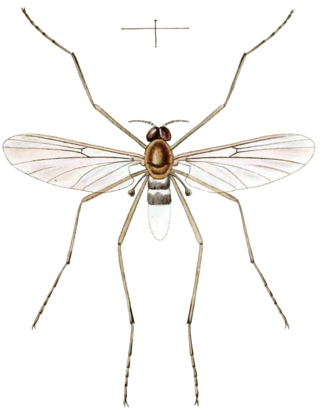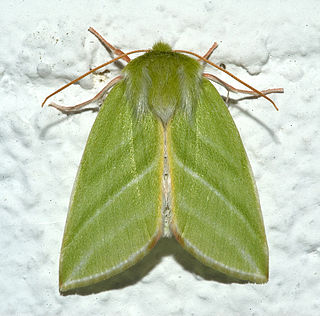
Heterotardigrades (Heterotardigrada) is a class that includes tardigrades that have cephalic appendages and legs with four separate but similar digits or claws on each. 444 species have been described.

Eutardigrada are a class of tardigrades (Tardigrada) without lateral appendages. Primarily freshwater bound, some species have secondarily gained the ability to live in marine environments (Halobiotus). By cryptobiosis many species are able to live temporarily in very dry environments. More than 700 species have been described.

The Blephariceromorpha are an infraorder of nematoceran flies, including three families associated with fast-flowing, high-mountain streams, where the larvae can be found.

Ypsolophidae is a family of moths with some 160 species. They are included in the Plutellidae by many authors.

The Drepanidae are a family of moths with about 660 species described worldwide. They are generally divided in three subfamilies, which share the same type of hearing organ. Thyatirinae, previously often placed in their own family, bear a superficial resemblance to Noctuidae. Many species in the drepanid family have a distinctively hook-shaped apex to the fore wing, leading to their common name of hook-tips.

Nolidae is a family of moths with about 1,700 described species worldwide. They are mostly small with dull coloration, the main distinguishing feature being a silk cocoon with a vertical exit slit. The group is sometimes known as tuft moths, after the tufts of raised scales on the forewings of two subfamilies, Nolinae and Collomeninae. The larvae also tend to have muted colors and tufts of short hairs.
Coelolepida is a clade of insects in the lepidopteran order, containing the infraorders Acanthoctesia, Lophocoronina, Neopseustina, Exoporia and Heteroneura, with the latter three grouped in clade Myoglossata.

The Cycloramphidae are a family of frogs endemic to southeastern Brazil. This family has seen large changes in its composition. Genera that have at some point been included in the Cycloramphidae are at present placed in the Alsodidae, Hylodidae, Leptodactylidae, and Rhinodermatidae. Of these, the Alsodidae and/or Hylodidae have also been considered as subfamilies of Cycloramphidae ; the Cycloramphidae, as recognized at present, would be similar to subfamily Cycloramphinae under such system.

The Glyphipterigidae are a family of small moths commonly known as sedge moths, as the larvae of many species feed on sedges and rushes. More than 500 species have been described in the family.

Lyonetiidae is a family of moths with around 200 described species. These are small, slender moths, the wingspan rarely exceeding 1 cm. The very narrow forewings, held folded backwards covering the hindwings and abdomen, often have pointed apices noticeably up- or down-turned. The larvae are leaf miners.

Endeostigmata is a suborder of acariform mites. There are about ten families in Endeostigmata. The grouping is strongly suspected to be paraphyletic, containing unrelated early diverging lineages of mites.

Pachylaelapidae is a family of mites in the order Mesostigmata. There are about 16 genera and more than 200 described species in Pachylaelapidae.

Callipodida is an order of millipedes containing around 130 species, many characterized by crests or ridges.

The Odontophrynidae are a family of frogs from southern and eastern South America. This family was first established in 1969 as the tribe Odontophrynini within the (then) very large family Leptodactylidae. Molecular phylogenetics analyses prompted the move of this group to the Cycloramphidae in 2006, before they became recognized as their own family Odontophrynidae in 2011.

Eulepidoptera is a division of lepidopterans in the infraorder Heteroneura.
Limnocharidae is a family of mites in the order Trombidiformes. There are at least 4 genera and about 12 described species in Limnocharidae.

Choctella is a genus of millipedes in the monotypic family Choctellidae. Its two species are native to the south-eastern United States. C. cumminsiChamberlin, 1918, occurs on the Cumberland Plateau from central Tennessee to northern Alabama and C. hubrichtiHoffman, 1965, occurs in central Alabama.
Thyasidae is a family of mites in the order Trombidiformes. There are about 7 genera and more than 30 described species in Thyasidae.
Adamystidae is a family of mites in the order Trombidiformes. There are at least three genera, one of which is extinct, in Adamystidae. It is the sole family in the monotypic superfamily Adamystoidea.
Anystoidea is a superfamily of mites in the order Trombidiformes.















